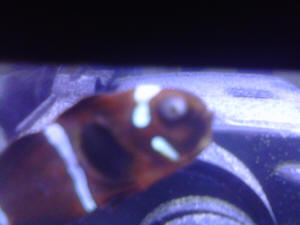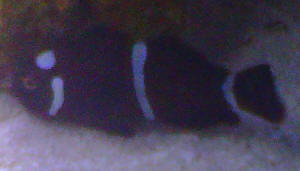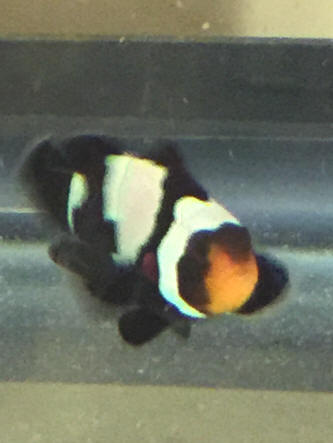|
FAQs about the Genetic Diseases of
Clownfishes
Related FAQs: Clownfish Disease 1, Diseases of Clownfishes 2, Diseases of Clownfishes 3, Clownfish Disease 4, Clownfish Disease 5, Clownfish Disease 6, Clownfish Disease 7, Clownfish Disease 8, Clownfish Disease 9, Clownfish Disease 10, Clownfish Disease 11, Clownfish Disease 12, Clownfish Disease 13, Clownfish Disease 14, Clownfish Disease 15, Clownfish Disease 16, Clownfish Disease 17, Clownfish Disease 18, Clownfish Disease 19, Clownfish Disease 20, Clownfish Disease 21, Clownfish Disease 22, & FAQs on
Clownfish Disease By: Environmental
Stress, Nutrition, Social/Behavioral/Territoriality, Trauma/Mechanical Injury, & Pathogens:
Lymphocystis, Infectious Disease (Bacteria, Fungi...),
Protozoans: Cryptocaryon/Ich,
Amyloodinium/Velvet, Brooklynella (see article below), &
Mysteries/Anomalous Losses, Cure, Success Stories, & Clownfishes in General, Clownfish Identification, Clownfish Selection, Clownfish Compatibility, Clownfish Behavior, Clownfish Systems, Clownfish Feeding, Clownfishes and
Anemones, Breeding Clowns,
Related Articles: Clownfish Disease, Clownfishes, Maroon
Clowns, Marine Disease,
Brooklynellosis,
|


|
|
7 year old female clown holds mouth open and won't or can't eat.
5/1/17
I just noticed that the ridge on her back looks a little ragged compared to
his. Here is another video and photo.
<This fish's mouth appears damaged... either from trauma or genetics. Not
much you can do other than be patient and hope. Bob Fenner>
7 year old female clown holds mouth open and won't or can't eat.
5/1/17
> Here is a video and photo :
<Ditto>
|
 |
Ocellaris anomaly? 7/19/15
Thanks for all the great info. I was at the LFS the other day and saw a tankful
of maybe 12 smallish to medium ocellaris clowns. I am thinking in the future of
having a pair but I noticed something odd. Two of the fish had
noticeably larger jaws.
<Ahh! One of a few common genetic flaws in captive breds here>
Realizing that there are so many variants these days, I'm not sure if it is
normal to see differences in shape as we see in color. Their mouths were not
stuck open and they seemed to be buzzing around just as well as the others.
Would you avoid purchasing such a fish?
<Mmm; well; for appearance sake perhaps; though as you state, not if the trait
were not debilitating>
Is it possible for a healthy fish to be shaped differently since they are being
bred like crazy and in so many different combinations?
<Yes; though this, pectoral fins of different size (ala Nemo; yes), flattened
heads.... are part of all their genetic make-up.
Bob Fenner>
|
Clownfish with protruding gill
12/19/14
Hello,
I searched WetWebMedia to the best of my ability for my Clownfishes
particular issue. After I received the clownfish I immediately noticed a
bright red gill sticking out from underneath it's right gill flap during
the acclimation process. This is a ORA snowflake clownfish. I have had
the fish for five days now. It is eating like a pig and is swimming
around normally. The only problem I have observed, besides the exposed
gill, is very rapid breathing. As far as my tank parameters go this is a
QT tank.
Ammonia-0, Nitrite-0, Nitrate-5, pH-8.1, salinity-1.024,
Temperature-80.4.
I hope the pictures I attach will work. Thank you for your time.
<Yes; a not-uncommon issue with tank-bred fishes of their size,
type/species; Clownfishes do have "bent" gill covers... either from the
process of growing up crowded (injury) or genetic expression. Generally
such fishes live just the same... and there is no "treatment" for such.
If you're very bothered, the fine folks at ORA will likely
credit/replace this one specimen. Bob Fenner>
|

.JPG) |
|
Maroon Clownfish
1/28/12
Hello crew, Jake here! I hope your having as great of a day as i
am!
<I hope you are>
The reason i am writing you, is because I'm having some
thought about my recent addition to my tank: a small ORA Yellow
Striped Maroon Clownfish.
I got him as a replacement to my poor Perc that i lost a few
weeks ago do to a powerhead malfunction. I got him because
he was a bit smaller, and that's what i was looking for, he
seemed like he was in good health and the shop owner has had him
for several months before i got him and said he was eating
well. Its been a day or so, and after some serious
inspecting of him, he doesn't fit the normal profile of a
Maroon Clown,
<No... has genetic issue/s>
or so i think. He small, only about a inch and a half, and
he has a body shape much like a Perc clown, but he is a deep red,
almost brown in color with a few small patches of lighter orange,
and his stripes are white as far as i can tell.
I did not notice this because the glass on the tanks at the store
are tinted ( i think ) ad throws the colors off. I'm
wondering if he may not be a Maroon at all.
<Is a Premnas; just diffed>
Ill attach some pictures, although he didn't make it
easy getting some pictures that were not a total blur. If
you could lend a hatchet to my intellectual thicket, that would
be amazing.
Once again, thank you crew!
<Read here: http://www.wetwebmedia.com/maroonclnart.htm
the linked files above; and search WWM w/ the string
"Clownfish Genetic Disease"
Bob Fenner>
|
|
 
Maroon Clownfish Follow up, genetic
issue/s 1/31/12
Hey Bob, thanks for getting back to me so quickly!
<Welcome>
I'm having a hard time locating the information on Clownfish
Genetic Diseases. If you could just relay the information
about it to me directly, or perhaps give me a straight link to
the page, that would be great. Is a genetic disease like
this common? Will it affect life span / longevity?
<Was very common two-three decades back when Clown breeding
was in its heyday... Don't know specific references (try the
search tool on WWM), but the pix you sent do show this specimen
to be deformed... Such individuals should really be destroyed...
As yes, they very often don't live well or long. BobF>
<<<<<Thanks so
much,>>>>>>>>
Jake
Re: Maroon Clownfish Follow
up 1/31/12
Little harsh don't yeah think?
<Mmm, no>
Because of theological reasons i have to value all life,
including the genetic unfortunate, while i realize his
days may be numbed, my course of action will be to, medicate and
nourish to provide as best a home as i can to ease what time he
has left and enjoy his presence in the tank. If you do
stumble about any information on the matter please write back as
i will be interested to hear.
Thanks for the swift replies Bob,
J Larson
<I too value all life. B>
|
|
|

